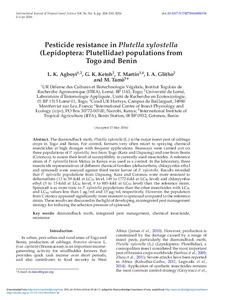| dc.contributor.author | Agboyi, L.K. |
| dc.contributor.author | Ketoh, G.K. |
| dc.contributor.author | Martin, T. |
| dc.contributor.author | Glitho, I.A. |
| dc.contributor.author | Tamo, M. |
| dc.date.accessioned | 2019-12-04T11:04:40Z |
| dc.date.available | 2019-12-04T11:04:40Z |
| dc.date.issued | 2016-12 |
| dc.identifier.citation | Agboyi, L.K., Ketoh, G.K., Martin, T., Glitho, I.A. & Tamo, M. (2016). Pesticide resistance in Plutella xylostella (Lepidoptera: Plutellidae) populations from Togo and Benin. International Journal of Tropical Insect Science, 36(4), 204-210. |
| dc.identifier.issn | 1742-7584 |
| dc.identifier.uri | https://hdl.handle.net/20.500.12478/1478 |
| dc.description | Published online: 17 August 2016 |
| dc.description.abstract | The diamondback moth, Plutella xylostella (L.) is the major insect pest of cabbage crops in Togo and Benin. For control, farmers very often resort to spraying chemical insecticides at high dosages with frequent applications. Bioassays were carried out on three populations of P. xylostella, two from Togo (Kara and Dapaong) and one from Benin (Cotonou), to assess their level of susceptibility to currently used insecticides. A reference strain of P. xylostella from Matuu in Kenya was used as a control. In the laboratory, three insecticide representatives of different chemical families (deltamethrin, chlorpyrifos ethyl and spinosad) were assayed against third instar larvae of P. xylostella. Results revealed that P. xylostella populations from Dapaong, Kara and Cotonou were more resistant to deltamethrin (13 to 59-fold at LC50 level, 149 to 1772-fold at LC90 level) and chlorpyrifos ethyl (5 to 15-fold at LC50 level, 9 to 885-fold at LC90 level) than the reference strain. Spinosad was more toxic to P. xylostella populations than the other insecticides with LC50 and LC90 values less than 1 μg/ml and 15 μg/ml, respectively. However, the population from Cotonou appeared significantly more resistant to spinosad compared to the reference strain. These results are discussed in the light of developing an integrated pest management
strategy for reducing the selection pressure of spinosad. |
| dc.description.sponsorship | Orskov Foundation |
| dc.format.extent | (204-210) |
| dc.language.iso | en |
| dc.subject | Integrated Pest Management |
| dc.subject | Insecticide |
| dc.subject | Deltamethrin |
| dc.subject | Togo |
| dc.subject | Diamondback Moth |
| dc.subject | Chemical Insecticide |
| dc.subject | Resistance |
| dc.title | Pesticide resistance in Plutella xylostella (Lepidoptera: Plutellidae) populations from Togo and Benin |
| dc.type | Journal Article |
| dc.description.version | Peer Review |
| cg.contributor.affiliation | Institut Togolais de Recherche Agronomique |
| cg.contributor.affiliation | Université de Lomé |
| cg.contributor.affiliation | Centre de Coopération Internationale en Recherche Agronomique pour le Développement |
| cg.contributor.affiliation | International Centre of Insect Physiology and Ecology |
| cg.contributor.affiliation | International Institute of Tropical Agriculture |
| cg.coverage.region | Africa |
| cg.coverage.region | East Africa |
| cg.coverage.region | West Africa |
| cg.coverage.country | Benin |
| cg.coverage.country | Kenya |
| cg.coverage.country | Togo |
| cg.isijournal | ISI Journal |
| cg.authorship.types | CGIAR and developing country institute |
| cg.iitasubject | Disease Control |
| cg.iitasubject | Pests Of Plants |
| cg.journal | International Journal of Tropical Insect Science |
| cg.howpublished | Formally Published |
| cg.accessibilitystatus | Open Access |
| local.dspaceid | 80592 |
| cg.targetaudience | Scientists |
| cg.identifier.doi | https://dx.doi.org/10.1017/s1742758416000138 |

